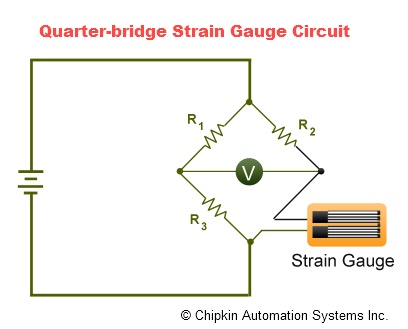Strain Gauge: Precision Measurement Tool
Introduction
Any external force applied to a stationary object produces stress and strain. The object's internal resisting forces are referred to as stress while the displacement and deformation that occur is termed as strain. Strain can be either compressive or tensile and is usually measured by strain gauges. In general, strain gauges are devices used to measure displacement, force, load, pressure, torque or weight.
Main Features
Following are the key features of a strain gauge:
Strain-gauge sensor is one of the most commonly used means of load, weight, and force detection.
It is a device which is used for measuring the changes in distances between points in solid bodies that happen when the body is deformed.
Resistance strain gauge is a helpful tool in the field of experimental stress analysis. It operates on the principle that the electrical resistance of a copper or iron wire changes when the wire is either stretched or compressed.
Usual strain gauge resistances range from 30 Ohms to 3 kOhms (unstressed).
Size of strain gauges is normally smaller than a postage stamp.
An ideal strain gage is small in size and mass, low in cost, easily attached, and highly sensitive to strain but insensitive to ambient or process temperature variations.
The ideal strain gauge would undergo change in resistance only because of the deformations of the surface to which the sensor is coupled. However, in real applications, there are many factors which influence detected resistance such as temperature, material properties, the adhesive that bonds the gage to the surface, and the stability of the metal.
Gauge Factor
Essentially, all strain gauges are designed to convert mechanical motion into an electronic signal. The strain experienced by the sensor is directly proportional to the change in capacitance, inductance, or resistance of the gauge used. For instance, if a wire is held under tension, it gets slightly longer and its cross-sectional area is reduced. This causes a change in its resistance proportional to the strain sensitivity of the wire's resistance. When a strain is introduced, the strain sensitivity, which is also known as the gage factor (GF) of the sensor, is given by:
 Where, RG is the resistance of the undeformed gauge,
Where, RG is the resistance of the undeformed gauge, R is the change in resistance caused by strain, and
R is the change in resistance caused by strain, and is strain.
is strain.
Applications
Strain gauges are frequently used following areas
- In mechanical engineering research and development to measure the stresses generated by machinery
- Aircraft component testing: Tiny strain-gauge strips glued to structural members, linkages, and any other critical component of an airframe measure stress
Strain Gauge Characteristics
Every strain gage wire material has its own characteristic
- Gauge factor
- Resistance
- Temperature coefficient of gage factor
- Thermal coefficient of resistivity
- Stability
Strain Gauge Materials
Typical materials include:
- Constantan (copper-nickel alloy)
- Nichrome V (nickel-chrome alloy)
- Platinum alloys (usually tungsten)
- Isoelastic (nickel-iron alloy)
- Karma-type alloy wires (nickel-chrome alloy)
- Foils
- Semiconductor materials
The most popular alloys employed for strain gages are copper-nickel alloys and nickel-chromium alloys.
Temperature Effects
High temperatures can affect the internal structure of strain-sensing materials like copper.
Temperature can influence not only the properties of a strain gage element, but also can amend the properties of the base material to which the strain gage is attached.
Variation in expansion coefficients between the gage and base materials may cause dimensional changes in the sensor element.
Expansion or contraction of the strain-gage element or the base material can result in errors which are extremely intricate to correct. For example, a change in the resistivity or temperature coefficient of resistance of the strain gage element can modify the zero reference used to calibrate the unit.
Measuring Circuits
For measurement of strain via a bonded resistance strain gage, it must be connected to an electrical measuring circuit which can measure even the minute changes in resistance corresponding to strain. Modern strain-gage transducers usually employ a grid of four strain elements electrically connected to form a Wheatstone bridge measuring circuit. A Wheatstone bridge is a divided bridge circuit employed for the measurement of static or dynamic electrical resistance.The output voltage of the Wheatstone bridge is expressed in millivolts output per volt input. Besides, this bridge circuit is appropriate for temperature compensation. A quarter bridge strain gauge circuit is shown in the figure below:
Following steps should be followed while checking strain gauge installations:
First of all measure the base resistance of the unstrained strain gage after its proper mounting but before complete wiring.
Check for surface contamination by measuring the isolation resistance between the gauge grid and the stressed force detector specimen by means of an ohmmeter, if the specimen is conductive. This should be done before connecting the lead wires to the instrumentation.
Also, check for irrelevant induced voltages in the circuit by reading the voltage when the power supply to the bridge is disconnected. Ensure that Bridge output voltage readings for each strain-gage channel are practically zero.
Now, connect the excitation power supply to the bridge and verify both the correct voltage level and its stability.
Test out the strain gage bond by applying pressure to the gage. The reading should not be affected.
Sources
Comments (0)
